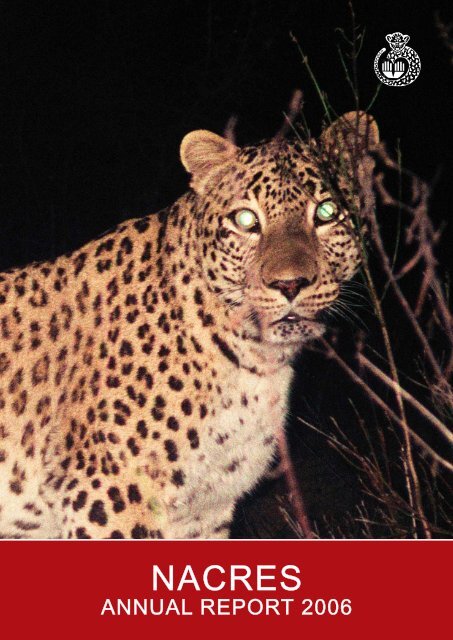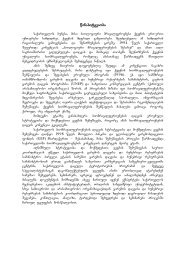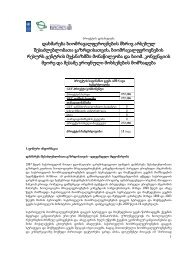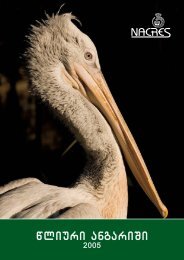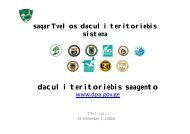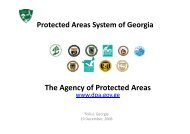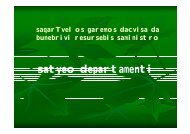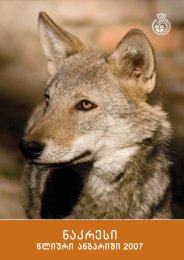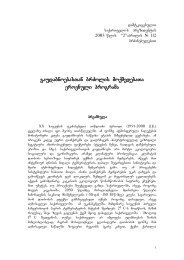Download - Nacres
Download - Nacres
Download - Nacres
You also want an ePaper? Increase the reach of your titles
YUMPU automatically turns print PDFs into web optimized ePapers that Google loves.
CONSERVATION OF BROWN BEARIN GEORGIAThe project “Conservation of Brown Bear in Georgia” funded byAlertis – Fund for Bear and Nature Conservation that was launchedin 2005 continued throughout 2006. The project aimed to bringabout a better understanding of various ecological aspects of brownbears in the Vashlovani National Park. Fieldwork under this projectinvolved the use of radio telemetry and photo trapping. Resultingrecommendations will be then drafted in the nearest future forsubsequent use in the conservation management of brown bear andother large carnivore species that are found in the national park.
BEAR RADIO TRACKINGCONDUCTED IN GEORGIA FORTHE FIRST TIMEDespite a determined effort and extensive fieldwork no bearswere captured for radio collaring in 2005. Nevertheless, wegained a vast amount of experience in learning to set upbear traps and selecting suitable bait for the Vashlovanibears.Finally, after one month of continuous fi eldwork in the springof 2006, all the hard work paid off on April 15 with the captureof our fi rst bear.staggered to the nearest stream, took a drink of waterand laid down in a patch of nearby shrubbery to recover.After a few hours we saw him roaming in the gorge andwe were then able to track him later in the evening with theinterception of the first radio signal.The process of radio tracking turned out to be quitechallenging. The deep narrow gorges of the VashlovaniNational Park serve as a natural barrier, and radio signalsare often interrupted, weakened, or can even bounce fromthe bear’s collar into another direction. NACRES membershad been trained in large mammal radio-tracking in relativelyThe bear had been visiting the trap site and successfullymaking away with the bait for several days. We were rathersurprised at how it managed to get away with the bait so manytimes without triggering the spring activated leg-hold snare.Nonetheless, our patience was fi nally rewarded with our firstcaptured bear. The bear was first immobilized safely, treatedas outlined in the special fi eld protocol, radio-collared andthen released without any problems. This overall successhad marked the beginning of radio-telemetry research forbrown bears in Georgia.We used a special mixture of tranquillising drugs that wereinjected into the captured bear and it fell asleep after a shorttime. Following the fi eld protocol for bear immobilisation andradio collaring, we followed all the necessary proceduresin attempting to handle the bear as quickly as possible inavoiding any possible health complications or physicalinjuries. It was a young male, judging from its body size andcondition of teeth, probably about 4 years of age. Havingchecked if the radio collar was working correctly we theninjected a reversal agent and walked quite a safe distanceaway from the capture site to observe him waking up safelyfrom the nap. The bear fi rst lifted his head, than stood up,Bejan Lortkipanidze, radio-tracking at Vashlovani National ParkPhoto: Misha Sharashidzeflat areas of Sweden and Kenya. But hunting for a radiosignal in the rugged terrain of Vashlovani was a totally newexperience for all of us.Despite these difficulties, we were able to successfullycollect a great deal of data on the habits and movement ofthe radio-collared bear. We found where the animal restedduring the daytime (so-called daybeds). We found outwhat were preferred feeding sites during different seasonsof the year (spring and summer). In summer, 24-hourobservations allowed us to learn the animal’s high activityperiods throughout the day. In all, our data showed that thebear moved over long distances and that may have beenan indicative of how large was his home range. A maximumdistance between two locations was recorded to as muchas 16 kilometres. Notably he often left the territory of thenational park to feed in the agricultural fields located to thenorth.NACRES’ Bejan Lortkipanidze , 18th InternationalConference on Bear Research and Management, Karuizawa,Japan, October 2006In the summer of 2006 we began another round of fieldworkto live trap more bears for the radio telemetry study. However,we soon we encountered a slight problem – for the first timeever in over a decade of doing field research on the site thestate border guard refused our working in certain regions ofANNUAL REPORT 20065
Bear locations in Vashlovani National Park, results of radio-trackingthe National Park. Consequently the fieldwork was disruptedand as instructed by the local border police, we had to returnto the capital and apply for a special permit to continue ourfi eldwork in the border zone.Fieldwork was resumed in August. However, more badnews was waiting for us. After days of radio tracking westill could not catch a signal from the radio-collared bear.We scanned practically the entire national park in trying topick up a signal, checking out every single little gorge aswe thought that this rugged terrain was most likely why wewere unable to receive the signal. Later we learned fromlocals that poachers had shot a bear wearing a collar in asunfl ower fi eld. Upon closer investigation, it soon becameapparent that this bear was killed at the time our bear hadstopped sending a signal.to Vashlovani National Park will be solved in the nearestfuture.Our study once again proved that it is not enough to protectfar-ranging species like the brown bear on protected areasalone - poaching has to be exterminated from adjacentareas as well. It will take concerted activities by each ofthe responsible agencies, which to include Protected AreasDepartment and the Environmental Police, as well as thegreater involvement of the general public in tackling illegalhunting in close proximity to the Vashlovani National Park.Otherwise the unique but fragile population of bears inVashlovani will remain under constant and imminent threatof extinction.ANNUAL REPORT 2006Despite this unfortunate setback, we still plan to continueconducting bear research using radio telemetry. We hadto overcome many obstacles and gained a great amountof experience trying to trap the fi rst individual and in theprocess of radio-tracking him. We can say with pride thatbear radio-tracking has been successfully introduced intoGeorgia and this first step is great reinforcement in beingmore motivation to continue our work into the future. Weintend to radio collar at least 3 new bears in 2007. We hopethat the problem of illegal shooting in the areas adjacent6
MONITORING OF LARGEMAMMALS WITH REMOTESENSING CAMERASMonitoring of large mammals with remote sensing monitorsin Vashlovani National Park continued throughout 2006.Almost all large mammal species found in the park werecaptured on the fi lms of our remote sensing camerasincluding wolf, bear, lynx, leopard and wild boar. Notably wecollected quite a number of new photos of Noah, the famousVashlovani leopard. Together with data from the previousyears photo trapping, information gathered during 2006 willhelp to better understand the ecology of the large mammalcommunity in the Vashlovani National Park.ANNUAL REPORT 20067
IMPLEMENTATION OF NATIONALBIODIVERSITY STRATEGY ANDACTION PLAN/ECOSYSTEMS ANDSPECIES CONSERVATION: BROWNBEAR (PHASE I)The project was launched in June 2004 with fi nancial support ofEnvironmental Investment Program of BP and BTC co. and SCP Co.Ltd. It was dedicated to the conservation of brown bear and its habitatin the Trialeti range and Borjomi-Kharagauli National Park. Phase 1was completed in summer 2006. Shortly afterwards a project proposalfor Phase 2 of this initiative was elaborated and submitted to BP andBTC C. and SCP Co. Ltd. for funding.
The fi rst phase of the project was dedicated primarily to abaseline study and to the participatory development of theaction plan for the conservation of brown bears in Trialetimountain range and within the Borjomi-Kharagauli NationalPark.Kharagauli National Park was fully elaborated. It was thendistributed among all stakeholders for their review. Thefinal version of the plan based on their feedback was laterprepared and presented at a second stakeholder workshopthat was organised in Tbilisi in July 2006.Apart from NACRES members, the project team consistedof world-renowned bear experts: Dr. Djuro Huber fromCroatia and Dr. Jon Swenson from Norway. There were alsoNACRES volunteers who participated in collecting largequantities of essential fi eld data.Results of fi eld and desktop studies conducted in 2004-2005were compiled in the document entitled Bear PopulationStatus Report. This report consists of the following chapters:A short description of study area with socio-economic anddemographic variables by district (Tetritskaro, Gori andBorjomi); bear habitats and their status – classificationof forest habitats, condition of forests (canopy cover,horizontal visibility, the level of forest degradation), statusof bear population (density index, spatial and temporalpatterns in distribution, minimum population size); utilizationof forest resources per district (offi cial records, trends inforest exploitation over the last 10 years, use of fuel wood,underlying reasons that contribute to the illegal use of forestresources); public attitudes toward bears; current threats tobears and their habitat (poaching, increased access to bearhabitat, logging operations, human-brown bear conflict, andthe lack of public awareness).The Brown Bear Conservation Action Plan has been basedon a participatory approach to nature conservation. It isalso a complex document and each of its components willrequire collected contributions of various stakeholders aswell as their concerted action in follow-up. Moreover, thesuccessful implementation of this plan is impossible withoutactive public participation. The ultimate goal of the plan isto ensure the co-existence of bears and humans by theIn February 2006 a stakeholder workshop was held andamong participants were international experts working withthe project. A fi rst draft report of the bear population statuswas presented and discussed. Also, an outline of a brownbear conservation action plan for Trialeti range and Borjomi-Kharagauli National Park was drafted and shared at theworkshop.After receiving and incorporating comments of manystakeholders, the project team completed the final documentof the bear population status report. Based on this document,as well as on international experience, a draft Brown BearConservation Action Plan for Trialeti range and Borjomi-Status Report and Conservation Action Plan for theBrown Bear Population of the Trialeti Range andBorjomi-Kharagauli National Park“The Environmental Investment Program (EIP) is initiated and funded by BP and its partners in BTC Co. and SCP Co. Ltd. Theprincipal objective of the EIP is to promote and conserve biodiversity. The EIP is divided into a number of different themes, whichwere identified during a process of consultation with national and international stakeholders. The present project is one of the EIPthemes. This document has been produced with the support of BP and its partners in Baku-Tbilisi-Ceyhan Company and SouthCaucasus Pipeline Company Limited. The views expressed herein are those of NACRES and can therefore in no way be takento reflect the official opinion of BP and its partners in BTC Co. and SCP Co. Ltd.”ANNUAL REPORT 20069
6. CONFLICT BETWEEN BEARS AND LOCALFARMERS6.1 Preventive measures against crops and livestockdamage inflicted by bears6.2 Establishment of an Intervention Group7. BEAR POPULATION RECOVERY7.1 Brown bear population recovery in the AlgetiNature Reserve7.2 Brown bear population recovery in the huntingreserve “Fauna”8. TOURISM AND BEARS9. CURRENT LEGISLATION AND BEAR HUNTING10. MONITORING OF BEAR POPULATION11. RESEARCH12. CAPTIVE BEARS13. PUBLIC INFORMATION AND PARTICIPATION INDECISION-MAKING PROCESSESBear footprint in Borjomi-Kharagauli National ParkThe Bear Population Status Report and the action planwere published in Georgian and distributed among allstakeholders involved in their development, as well asamong other interested organisations, individuals andvarious other stakeholders.implementation of various conservation practices. Thevision is as follows: the existence of bears in Georgianforests is not only widely accepted by the society as a wholebut that the local population is also interested in maintainingsustainable bear populations.The action plan consists of the following chapters:The Brown Bear Conservation Action Plan for Trialeti Rangeand Borjomi-Kharagauli National Park is a public document.The Ministry of Environment has approved it as a guidingdocument. Counted among the potential executors ofindividual components of this plan include NGOs, privatesector representatives as well as a range of interestedindividuals.1. PREAMBLE2. INTRODUCTION3. GOALS4. HABITAT CONSERVATION4.1 Campaign against illegal logging4.2 Development of recommendations to minimize theimpact of forestry operations4.3 Monitoring of human-induced succession in forestecosystemsANNUAL REPORT 2006105. CONTROL OF ILLEGAL BEAR HUNTING5.1 Encourage cooperation between thepublic and the local Environmental Inspection Unit5.2 Conducting public awareness activitiesFinal stakeholder workshop, Tbilisi, July 12, 2006
CAPTIVE BEAR ASSESSMENT INGEORGIAIllegal capturing of bears, mostly cubs, has become a widespreadform of poaching in Georgia over the last decades. It poses a seriousthreat to the wild population of brown bear - a species on the NationalRed list as a critically endangered. Besides, it is illegal for individualsto keep bears captured from the wild. In 2006 we began the project -“Captive Bear Assessment in Georgia” with fi nancial support of Alertis,Fund for Bear and Nature Conservation, the Netherlands.
The goal of the project is to conduct an inventory ofbears being illegally kept in captivity throughout Georgia,and based on the collected information, to come up withan action plan in a participatory manner that would moreappropriately address the problem.Since the early 1990s the illegal capturing and keepingof brown bears in cages or as pets is becoming a commonoccurrence in Georgia. Today one can see captive bearsat roadside restaurants and petrol stations. In most casesthe initial motivation for keeping a bear is to attract morevisitors. In addition, bears are also kept as pets in privatehomes. Most of the captive bears have to live under harshconditions that are truly deplorable and inhumane. Mostare locked up in cages that fail to meet even minimumrequirements. The cages are typically small, dirty and lackany shade at all. Most often the bears are not receivingproper care or food. Bears are not even being supplied withdrinking water and there are also quality problems. Their dietis often extremely poor and comprises restaurant leftovers,mostly consisting of bread products and cooked food scraps.Some of them have to live under a constant noise of busyroads and the threat of being teased by crowds. In additionto those kept in permanent cages, street photographers areexploiting illegally captured bear cubs as a draw to attractcustomers (although luckily such photo gimmicks are nota common occurrence in Georgia). Most captive bearsshow acute signs of stress and neurosis (red eyes, unrest,repetitive movements and various stereotypic behaviours).There have been several instances observed of bears beingsubjected to torture, harassment and cruel treatment. Mostholders lack any knowledge as to how to take care of theircaptive bears. Owners do not observe even the most basicsafety rules and visitors are often exposed to potentialthreats. Overall, the existing situation is totally unacceptableto any humane society.Despite being primarily a conservation organisation,NACRES has been working on the problem of captive bearssince 1995. Nevertheless due to poor law enforcementstandards and the generally weak state of governmentalinstitutions, it has been almost impossible to effectivelyaddress the issue. Presently the Environmental Police andBiodiversity Protection Unit of the Ministry of EnvironmentalProtection and Natural Resources are both keenly interestedin resolving the problem. There is now renewal hope that withthe concerted efforts of relevant governmental agencies,including the NGO sector, and in tandem with general public,a determined effort will now be made to solve the problem ofcruelty to bears once and for all.2006 was dedicated to the first phase of the projectinvolving an extensive inventory of captive bears throughoutthe country. A total of 25 captive bears were recorded andinspected on-site. Detailed information on each individualbear was gathered and entered into a special database. Theproject will continue into 2007. A captive bear action plan willbe then established based on what the project determinesto be the problem and best solutions.ANNUAL REPORT 200613
Sergo Kalmakhelidze, a former animal warden of the Rustavi zoo continues to take care of thethree bears until their departure to HollandCAPTIVE BEAR RESCUEINITIATIVEIn August 2006 the Mayor of Rustavi stopped fi nancing the small zoolocated in the Rustavi Park. Most of the animals from this zoo wereable to fi nd a new home at the Tbilisi zoo, with the exception of threebears. The Tbilisi zoo did not have adequate facilities to accept theadditional adult bears. Humane destruction i.e. euthanasia of thethree homeless bears appeared to be the only solution at the time.However, thanks to the intervention of Alertis, a Dutch fund for bearand nature conservation, the three Rustavi bears have been givena second chance at life. It was decided to relocate them to the BearForest of the Ouwehands zoo in Rhenen, the Netherlands.
The project “Captive Bear Rescue Initiative” is supportedby Alertis and its sole purpose is to save the three Rustavibears from the imminent threat of being destroyed and tomove them to Holland namely to the Bear Forest, a specialbear shelter located on the grounds of the Owehands Zoo,Rhenen where they will fi nd a welcome and be able to liveout the rest of their lives.After the Rustavi municipality was unable to continue fundingthe small zoo located at the Rustavi Culture and RecreationPark, the majority of other animals were transported to theTbilisi zoo. However, this was not the fate of three malebears – Balu, Sasha and Misha. In close collaboration withthe former zoo management, we then started looking for anew home. Euthanasia seemed the only way out, as thereweren’t any suitable facilities available in Georgia for themto be moved. Alertis came to their rescue and the timing wasperfect. Three bears had recently died at the OuwehandsZoo in Holland.Finally, time was coming for the departure to their new home.The next task was to take on the responsibility for arrangingall necessary transportation and health documents, includinga CITES export permit. Possible routes and means oftransport are also being reviewed in cooperation with Alertis.We looked for possibilities of land or air transport that wouldpermit the live bears to be transported in compliance withinternational standards and in the most safe and humanmanner. The actual transportation of the bears to Holland istentatively scheduled for March-April 2007.Mr. Badri Gomarteli, the former Director of the Rustavi zoohad been providing food and care for the bears out of hisown pocket. Moreover, NACRES together with Tbilisi zoowas able to allocate some emergency funds to help Mr.Gomarteli keep the bears well supplied with nourishingfood and proper care. NACRES used its own resources inthe beginning to help keep the bears supplied with food.However, beginning in November of 2006 and onwards,it was possible to fully take over this responsibility thanksto the fi nancial support of Alertis. Simultaneously, Alertislaunched a nationwide fund raising campaign in Holland tocollect the vast sums of money needed to transport the bearsto their new home at the Bear Forest. The campaign wasvery successful and within the span of a relatively short fundraising campaign, enough donations were collected to fullycomplete the task. Meanwhile, with the approval of RustaviMunicipality, the three bears were transferred to NACRES’sownership for free. The Rustavi Park kindly agreed that thebears remain there until their planned departure to Holland.Not only did we supply all necessary food and funds for theanimal caretakers, veterinary service were provided on anas needed basis.Alertis launches a nationwide fund raising campaign to helpthe Rustavi bearsANNUAL REPORT 200615
CONSERVATION OF THE CAPRASPECIES IN GEORGIATwo species of tur are found in Georgia: East Caucasian Tur (Capracylindricornis) and West Caucasian Tur (Capra caucasica). BothIUCN and Georgian Red Lists of Threatened Species classify theEast Caucasian Tur as vulnerable (VU) and West Caucasian Tur as acritically endangered (CR) species.During 2005-2006, NACRES implemented the project Conservationof the Capra Species in Georgia supported by Critical EcosystemsPartnership Funds (CEPF) and WWF Caucasus Programme Offi ce.
The project was dedicated to the conservation of theendangered tur species in Georgia through the developmentand adoption of the National Tur Conservation Action Plan.The project began in Autumn 2005. Field surveys werecarried out in Lagodekhi Nature Reserve in 2005, and inthe Kazbegi and Svaneti regions in 2006. On the basis offieldwork data and existing literature, a population viabilityanalysis for the two species was completed. It demonstratedthat at the current unsustainable hunting levels extinctionof the tur population in Georgia over the span of the next50 years is highly probable. Consequently urgent action isnecessary to eliminate the current high rate of poaching.incorporated into the final draft document. Subsequentlya final report was prepared and published in Georgianand submitted to the Ministry of Environment, whichis now to be used as a guideline document for theconservation of Georgian tur species.The project was assisted by Dr. David Mallon, aninternational respected consultant for the project, as wellas by various NACRES volunteers.A comprehensive report describing the status of theendangered tur species was elaborated, based on whichthe draft Tur Conservation Action Plan for Georgia was thendeveloped for these two species. The draft document wasdistributed among various stakeholders, including relevantgovernmental agencies, NGOs, research organisationsand other interested individuals. It was also presented ata special stakeholder workshop. Many of the commentsand the feedback received from the stakeholders were thenThe Status and Conservation Action Plan for the Tur inGeorgia“The Critical Ecosystem Partnership Fund is a joint initiative of Conservation International, the Global Environment Facility, theGovernment of Japan, the MacArthur Foundation and the World Bank. A fundamental goal is to ensure civil society is engagedin biodiversity conservation.”ANNUAL REPORT 200617
EURASIAN OTTER RESEARCH ANDCONSERVATION IN GEORGIAIn the past Eurasian otter (Lutra lutra) was widespread in Georgia.Today the Eurasian Otter is one of the rarest vertebrate species inexistence in this country. Its status qualifi es for it to be included on theNational Red List as being a critically endangered in Georgia. Majorthreats to the species include illegal hunting, the decline of fi sh in therivers and overall habitat loss. The project, “Eurasian Otter Researchand Conservation in Georgia” funded by BP Exploration (CaspianSea) Ltd – Georgia was part of NACRES’ long-term study of the otterpopulation of the Alazani valley (East Georgia).
The project targeted the conservation and sustainablemanagement of threatened Eurasian otter populations inGeorgia through the reduction of human-carnivore conflicts,including (i) fi eld studies involving otter radio tracking, (ii)assessment of water contamination levels and its impact onaquatic life and (iii) public awareness activities.Alazani fl ood planes, the project’s target area is home toone of the few surviving otter populations. However, thereare upwards of 300 fi sh farms operating on small pondsor larger artifi cial lakes throughout the area. Moreover, theever-deteriorating irrigation system has left many canalswithout a supply of water. Moreover, illegal and over fishingusing poisons, electroshock devices and even dynamite,has resulted in a dramatic decline of fish stocks in the rivers.Otters that fail to fi nd food in their natural environmentbecame frequent visitors to the fi sh farms. It was onlynatural that an intense confl ict results between farmersand the survival needs of otters. The situation was madeworst with a lack of public awareness and an undevelopedunderstanding of wildlife conservation. Moreover, localshave negative attitudes toward wildlife, and especially wildcarnivores.In addressing the problem, NACRES team was assistedby international experts. Dr. Addy de Jongh and Dr.Tjibbede Jong, otter specialists, as well as Dr. Pete Klaver, aveterinarian; they were all from the Netherlands and cameto Georgia to participate in the fi eld work for otter radiotracking and to train NACRES team members and volunteersin methods of capturing otters and transmitter implantingprocedures. During the next fi eld trip, in late September2006, a fi rst otter - a young female was captured as a resultof several weeks of contentious fieldwork. The animal wasthen transported to Tbilisi zoo, where it was implanted witha transmitter. After a period of recovery the animal was soonreleased back into the wild in the same place where it wasfirst captured. This first individual caught and successfullyreleased back to the wild was then constantly monitoredthroughout the remaining term of the project.In addition to radio tracking, field surveys were conductedto investigate otter feeding habits and their seasonal anddaily movement patterns. We found that there was a markedseasonal movement of otters in the study area. Otters inresponse to the impact of humans have a tendency to seekshelter in fl ood plains of riparian forests and on small islandslocated in the Alazani River. Our studies also revealed thatotters cause only insignifi cant damage to the commercialfish farms.Field studies were undertaken to determine sources andlevels of heavy metals and other pollutants in the water andamong prey species. Laboratory results demonstrated thatsome sites on the river Alazani are heavily polluted withheavy metals and agricultural pesticides.Nevertheless it does appear that illegal fur trade anddepletion of fish supplies in the river are the main contributingreasons for the decline of otter populations. We knew of atleast 6 otters being captured and killed in the study areaover 8 months of the project. Illegal harvesting and killingof otters also seriously impacted our work. Moreover, therewere several instances when poachers interfered withour various attempts to capture otters for radio tracking.We reported the situation facing the Alazani flood plainsand the other problems encountered to the EnvironmentInspectorate and we were then promised that they wouldaddress our concerns.At the end of the project, we generated a document withrecommendations and suggested prevention measuresfor reducing human-otter conflicts. It was then distributedamong fish farms and to local authorities. NACRESotter research and conservation team will continue otterpopulation monitoring in the Alazani flood planes. The teamwill capture more animals for radio tracking in the future.Typical otter habitat in the Alazani valleyNACRES’ Giorgi Gorgadze catches his fi rst otterfor radio-trackingANNUAL REPORT 200619
TRAINING IN BIODIVERSITYMONITORING FOR PROTECTEDAREAS STAFFOne of the key roles of NACRES is to assist Georgia’s protectedareas in building their capacities. The majority of NACRES projectshave been directly related to the improvement of the ProtectiveAreas management and their effectiveness as a major tool forbiodiversity conservation. One way of strengthening any protectedarea is to increase the skill level and qualifi cations of its staffmembers. NACRES won a tender announced with the GEF/World
Bank funded Georgia Protected Areas Project for providing trainingto the staff of Vashlovani, Lagodekhi, Batsara-Babaneuri and Tushetiprotected areas; this project also involved training sessions inbiodiversity monitoring for relevant staff members of the ProtectedAreas Department. The assignment started in May 2006 and will becompleted in June 2007.In 2006, within the terms of the above-mentionedassignment, NACRES team members conducted trainingsessions for the staff of Vashlovani, Lagodekhi, Batsara-Babaneuri and Tusheti protected areas. The training wastargeted to gathering fi eld data as necessary for effectivebiodiversity monitoring. Later, in 2007, a comprehensivebiodiversity monitoring handbook and a field guide is to bepublished and this educational material will be especiallydesigned for these and other Georgian protected areas.Moreover, a general residential training will be organisedfor biodiversity monitoring planning and implementation,including fi eld data analysis. The training will last 10 daysattended by appropriate staff members representing all ofthe Georgian protected areas i.e. resource managementspecialists or research & monitoring specialists, heads ofrangers services, as well as employees representing theDepartment of Protected Areas.Field training sessions on the target protected areas wereplanned taking into account that (i) most (if not all) membersof the target protected areas lacked any experience of fielddata collection for biodiversity monitoring - many rangershad in fact been just recently recruited, (ii) fi eld trainingswould not have caused any delays or interference in normalfunctioning of the protected area and (iii) the groups shouldnot have been too large in order to ensure best resultsand create the possibility of providing an effective learningenvironment and working on an individual level.• Divide rangers in training groups and design a scheduletogether with the senior park management• Keep record of participant attendance to make sure thateach participant attends every component of the training(this will allow for some greater flexibility for rangers– anybody unable to attend a particular componentwith his own group would have a second chance to joinin another group on a different day in order to catch upon the material covered)• Each new component of the field training begins with abrief theoretical introduction and overview• Field activities last as long as needed for effectivelearning outcomes but still they depend on the time madeavailable to the participants by the park management• The following day of each session begins with thereview of already discussed components (and this allowsopportunities for additional explanations, or to evenrepeat a practical sessions, if needed).The following general guidelines were elaborated andapplied by the trainers in planning and implementationof field training sessions on each of the target protectedareas:ANNUAL REPORT 200621
Field training was dedicated to the following topics:• What is biodiversity monitoring and why it is needed forprotected areas?• General aspects of fi eld data collection in biodiversitymonitoring• Data collection for large mammals:most participants quickly learned how to make use of a GPSon a general user level. They were able to learn some ofthe most useful functions and operations that were relevantto their everyday work. For example, the rangers learned:marking a point and recording it in a GPS, transferring alocation onto map, search for previously recorded waypointsand navigation to a selected one, taking a location from amap and entering it into GPS for subsequent navigation.Rangers were quite amused to play a treasure huntinggame using GPS - it proved a useful practice for acquiringskills of using this device. The game basically involved thefollowing: one of the trainers would hide “treasure”, a bottleof beer or pack of cigarettes and take GPS readings for thesite on a piece of paper. Each participant was given one setof coordinates and they had to enter it into a GPS and followup by going out in search of the hidden treasure. Everyparticipant successfully navigated to the targeted site andfound the concealed “treasure”.• Direct (visual) observations• Footprint identifi cation• Use of remote sensing cameras (photo-trapping)• Data collection on plant species and plant communities(depending on season)• Use of GPS• Use of maps• Any other issue or question that may arise from theparticipants, with the exception of those falling into thescope of the theoretical training (not practical)Despite the fact that each of the target protected areaspossessed GPS handsets, the rangers had virtually noexperience in using the devices. Staff of the VashlovaniNational Park proved to the exception. Vashlovani isinstitutionally one of the most developed protected areasanywhere in Georgia. In addition NACRES in closecooperation with its management and active involvementof its staff members has been conducting various researchprojects and activities on this protected areas for manyyears, which has included the use of radio-tracking andphoto-trapping techniques. Consequently, rangers from theVashlovani National Park were already familiar with many ofthe topics to be covered in the fi eld training.ANNUAL REPORT 2006With few exceptions practically all participants of the fieldtraining sessions from all four protected areas showed aremarkable degree of motivation and ability to learn moreabout data collection and to become familiar with newtechnologies. Despite differences in individual capabilities,22
ENVIRONMENTAL INVESTMENTPROGRAM’S (EIP) SMALL GRANTSPROGRAM FOR NGO CAPACITYBUILDING (SGP) ALONG THE SCP ANDBTC PIPELINE ROUTESIn 2004 Save the Children Federation and NACRES jointly designedand implemented a project to strengthen the local environmentalNGO sector along the Baku-Tbilisi-Ceyhan pipeline route through theprovision of small grants. Environmental Investment Program (EIP)initiated by BP and its partners in BTC Co and SCP Co Ltd. supportedthe project. The Small Grants Program (SGP) was dedicated toaward grants for environmental projects with tangible outcomes anddemonstrated ability to make a difference in the Districts of Gardabani,Tetritskaro, Marneuli, Tsalka, Adigeni, Borjomi and Akhaltsikhe.
In the initial stage of the Small Grants Program (SGP)NACRES team conducted an assessment along the pipelineroute i.e. in Gardabani, Tetritskaro, Marneuli, Tsalka, Adigeni,Borjomi and Akhaltsikhe Districts to identify environmentalpriorities. The following priority issues were selected:• Biodiversity and its sustainable use• Soil degradation• Water pollution• WasteGuidelines for the 2004-2005 Small Grants Program wereestablished and they were based on the above-mentionedpriorities. The activities of the NACRES team were conductedin two stages.The fi rst stage involved a series of consultations for localNGOs and initiative groups. NACRES team memberscarried out meetings in each of the seven target districtsin order to present program priorities, and to further assistpotential applicants with project proposal development.In the next (second) stage NACRES team activities werefocused on providing technical assistance to the successfulapplicants. A series of trainings and seminars based onorganizations’ individual needs was then held. We alsoprovided advice about specifi c environmental issues relatedto the implementation of individual projects under the termsof the SGP.larger social dimension and in few instances involvedenvironmental benefits and outcomes. In reality theseprojects were not fully within the scope of SGP. As a resultof active consultations, those grant applications that weresubmitted later into the project were more in line with thegoals of the project. The emphasis had been shifted towardmainstream environmental issues and the most recentapplications were much better qualified for SGP assistanceand on target.Projects implemented under SGP during 2006 addressedsuch issues as the rehabilitation of fauna and flora speciesand their habitats, restoration of degraded forests andlandslides affected slopes, as well as setting up nurseries,assistance to protected areas, status assessment andrestoration of local natural monuments. Some projects werededicated to identification/mapping of soil degradation/erosion and the creation of environmental databases, aswell as the promotion and use of alternative energy sources,addressing waste management issues, including theshutting down and removal of illegal dumps and the overallimprovement of waste management at a local level.Almost all projects had a public awareness component. Theprogram placed a special emphasis on youth education.Numerous publications, newspaper articles and brochureswere published and widely distributed. Environmentalcamps were set up for students and a range of specialenvironmental events were also organised.A total of 28 environmental projects were funded in the twotarget regions: 1) Samtskhe-Javakheti (districts of Tsalka,Adigeni, Borjomi and Akhaltsikhe) and 2) Kvemo Kartli(districts of Gardabani, Tetritskaro and Marneuli) under theproject. It was the first time that some of the NGOs e.g. inTsalka, Adigeni and Tetritskaro had ever been involved withthe implementing of environmental projects. The result wasan increased interest in the fi eld of environment among theselected districts.The majority of grant applications in the beginning had aOne of the achievements of SGP has been an increasedlevel of awareness and degree of confidence amonglocal NGOs as to the role of local initiative in being ableto solve local environmental problems and in ensuring thesustainable use and management of natural resources.Overall, the programme was highly successful in that thecapacities of the environmental NGOs in the seven targetdistricts were considerably strengthened, several youngorganizations gained a valuable experience of projectapplication development and implementation and publicawareness and participation was increased.“The Environmental Investment Program (EIP) is initiated and funded by BP and its partners in BTC Co. and SCP Co. Ltd. Theprincipal objective of the EIP is to promote and conserve biodiversity. The EIP is divided into a number of different themes,which were identifi ed during a process of consultation with national and international stakeholders. The present project is oneof the EIP themes. This document has been produced with the support of BP and its partners in Baku-Tbilisi-Ceyhan Companyand South Caucasus Pipeline Company Limited. The views expressed herein are those of NACRES and can therefore in noway be taken to refl ect the offi cial opinion of BP and its partners in BTC Co. and SCP Co. Ltd.”ANNUAL REPORT 200625
ANNUAL REPORT 200626
ANNUAL REPORT 200627
Centre for Biodiversity Conservation and Research (NACRES)Abashidze Street 12 A, 0179, Tbilisi, GeorgiaTel: (+995 32) 23 37 06, Fax: (+995 32) 53 71 24E-mail: public.relations@nacres.org


